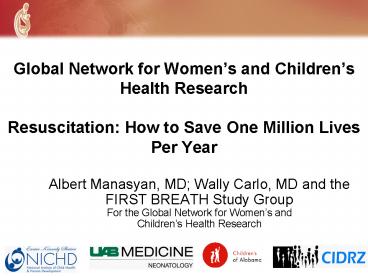Global Network for Women - PowerPoint PPT Presentation
1 / 15
Title:
Global Network for Women
Description:
Global Network for Women s and Children s Health Research Resuscitation: How to Save One Million Lives Per Year Albert Manasyan, MD; Wally Carlo, MD and the FIRST ... – PowerPoint PPT presentation
Number of Views:118
Avg rating:3.0/5.0
Title: Global Network for Women
1
Global Network for Womens and Childrens Health
ResearchResuscitation How to Save One Million
Lives Per Year
- Albert Manasyan, MD Wally Carlo, MD and the
FIRST BREATH Study Group - For the Global Network for Womens and
- Childrens Health Research
2
Stillbirth and Neonatal Deaths Per Year
- 98 of all stillbirths and neonatal deaths occur
- in developing countries
- 2.6 million stillbirths
- 3.5 million neonatal deaths
- Preterm 1.0 mil
- Birth asphyxia 0.8 mil
- Sepsis 0.5 mil
- Other 1.2 mil
3
Background Essential Newborn Care
- The WHO developed Essential Newborn Care (ENC)
course sets minimum standards for training birth
attendants in neonatal care including - Basic resuscitation
- Universal precautions
- Routine neonatal care
- Thermoregulation
- Breastfeeding
- Kangaroo mother (skin-to-skin) care
- Care of the small baby
- Danger signs
4
First Breath Protocols
- The First Breath protocols were designed to
address the impact of Essential Newborn Care
(ENC) on perinatal mortality - First Breath Clinic Study
- First Breath Common Protocol
5
Comparison of First Breath Protocols
First Breath Clinic Study First Breath Common Protocol
Setting Institution-based (first level health clinics) Community-based
Birth Attendants Formally-trained midwives All birth attendants including MDs, RNs, MWs, TBAs
Outcomes Early neonatal mortality (7 days), stillbirths, perinatal mortality Early neonatal mortality (7 days), stillbirths, perinatal mortality
Timeline 2004 2006 2007 2008
6
First Breath Clinic Study
- Design Pre-Post controlled study with active
baseline data collection - Setting Level 1 health delivery centers in
Zambia - Interventions WHO ENC (including resuscitation
training) and NRP - Patients 71,689 low risk newborns
- Carlo W et al. Pediatrics 126e1064-71, 2010.
7
First Breath Clinic Study
- Results Pre-ENC Post-ENC p value
- All cause 7-day mortality/1000 11.5 6.8 plt0.001
- Perinatal mortality/1000 18.3 12.9 p0.002
- Mortality due to asphyxia/1000 3.4 1.9 p0.02
- Mortality due to infection/1000 2.2 0.8 p0.02
- Mortality lt 1500/1000gr 576 407 p0.049
- SB rate/1000 4.9 4.9 NS
Carlo W et al. Pediatrics 126e1064-71, 2010.
8
Delivery by Birth Attendant
Carlo et al. N Engl J Med. 362614-23, 2010.
9
First Breath Common Protocol
- 1. Population-based prospective study
- 2. 96 communities in 6 countries (7 clinical
sites) in South America, Africa, and Asia - 3. 3,676 birth attendants trained in data
collection and clinical measures (fetal heart
rate monitoring, Apgar scoring etc.) - 4. Active baseline data collection
- 5. Training in ENC
- 6. Post-ENC data collection
10
First Breath Common Protocol
Carlo et al. N Engl J Med. 362614-23, 2010.
11
Pre-Post ENC Perinatal Mortality Rates by Birth
Attendant
Perinatal Mortality
Carlo et al. N Engl J Med. 362614-23, 2010.
12
Methods Cost Analysis
- Cost-effectiveness was calculated as follows
- Cost per life saved Cost
- Reduction in death
- Cost per disability-adjusted life years (DALY)
was calculated as follows - Cost per DALY Cost per life saved
- Life expectancy
13
Results DALY
- Cost per DALY Cost per life saved
- Life expectancy
- Cost per DALY 208
- 39.7 years
- Cost per DALY 5.24
14
Final Conclusions
- 1. WHO ENC training of midwives in first level
centers reduced neonatal mortality by 10/1000 - 2. This intervention was very cost-effective in
first level facilities (5 per DALY) - 3. In communities, ENC reduced fresh stillbirths
and perinatal mortality without increasing
neonatal mortality - 4. Survivors of birth asphyxia have low rates of
impairment
15
Acknowledgement
- Support for this project from the Eunice Kennedy
Shriver National Institute of Child Health and
Human Development (NICHD), part of the National
Institutes of Health within the U.S. Department
of Health and Human Services, and the Bill and
Melinda Gates Foundation































